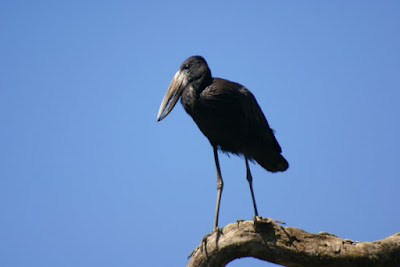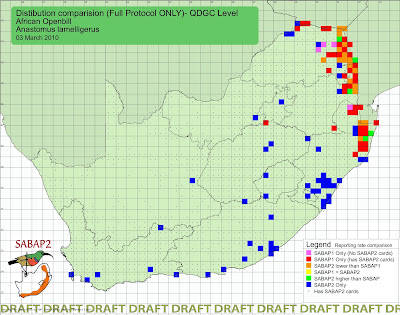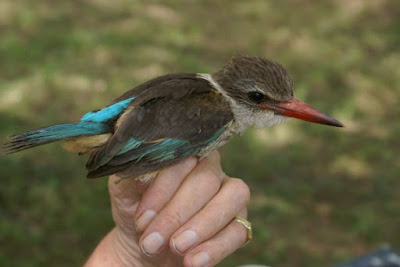 |
| Andy Ruffle's garden, Sea Park 8th March 2010 (Photo Andy Ruffle) |
The summer of 2009/2010 will be remembered for the unprecedented irruption of African Openbills Anastomus lamelligerus throughout South Africa. A fairly common resident in the lowveld and Zululand, it is a rare vagrant to other parts of the country. The first record of an out-of-range Openbill was a single bird in the KZN Midlands in mid-November 2009. Three days later, 30 were found near Potchefstroom in the North West Province. By the end of November a flock of 20 was seen in the Midlands and one bird was recorded near East London. By Mid-December birds had reached the Western Cape. Their numbers then started to climb. By Christmas there were sightings of flocks of 200 in southern KZN. It is hard to estimate the total number of out-of-range birds, but the irruption must have involved close to 1,000 individuals.
Two questions arise. Where did all these birds come from? And why did they move so far out of their normal range? The breeding population of Openbills in South Africa is only a hundred or so pairs, begging the conclusion that they moved into South Africa from further north. But quite where is unknown. Vast numbers breed in Zambia in winter and the timing of the irruption suggests that they could be birds dispersing from these colonies after breeding. Irruptions often involve young, naive birds, but adults as well as juveniles were involved in the recent movements. Interestingly, there were also a few Openbills on the move in 2008/2009, with one seen in Potchefstroom and another in the KZN Midlands. It is possible that small numbers of Openbills disperse south in early summer each year and that this event reached unprecedented proportions in 2009/2010.
We can only speculate why the 2009/2010 irruption occured. Conditions in the Openbill’s normal range have not been exceptionally dry or wet, but some of their traditional habitat has been lost due to the invasion of Mimosa pigra, a thorny shrub from South America that flourishes on seasonally inundated land. By 2005, more than 3,000 hectares of floodplain had been lost, and the weed continues to spread at an ever-increasing rate. Recent surveys on the Kafue Flats, in Zambia, show that areas invaded by Mimosa support just one percent of the number of Openbills compared to pristine floodplain (Shamunga 2009, Biodiversity 10: 56-60). Populations of many other waterbirds have also been severely impacted.
The Openbill event follows on the heels of an irruption of Marabou Storks Leptoptilos crumeniferus into the Western and Eastern Cape in 2008/2009. Both irruptions occurred in summer. As with the Openbills, the numbers of Marabous involved make it almost certain that the majority originated from outside South Africa. Some Marabous remained until June 2009, but have since disappeared.
How long the Openbills persist in their new environment remains to be seen. Indications are that they may have already left the South Coast. It seems highly likely that the Openbills were driven south and west by deteriorating environmental conditions in areas where they are naturally common.
Text extracted from Africa Birds & Birding, Vo. 15, No.2
 |
| SABAP2 map showing irruption of the Openbill throughout SA. Click here to see current distribution map |
 |
Margate Country Club Feb 2010 (Photo Clive Edmundson) |



























